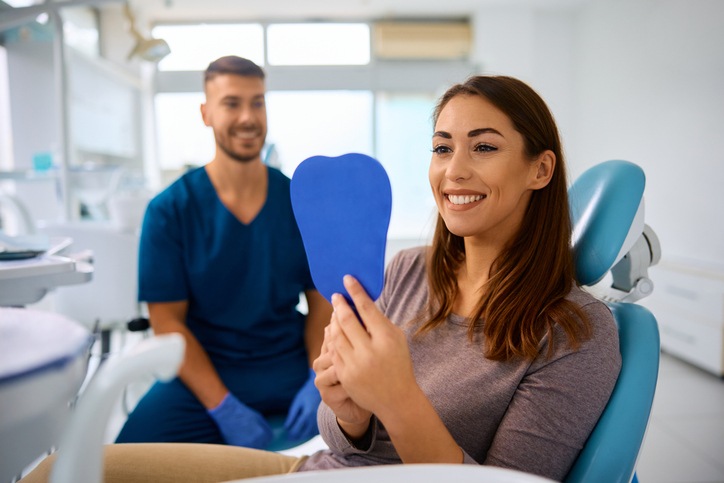Bone Grafting
Dental Bone Grafting Procedures in Frisco & McKinney, TX
Over time, the bone associated with missing teeth can atrophy or decrease in volume and density. This leaves a condition in which there is poor quality and quantity of bone, disqualifying some patients from dental implant replacement. Fortunately, Stonebriar Facial & Oral Surgery has the ability to grow bone where needed with various dental bone grafting procedures in Frisco and McKinney, TX.

What Is Dental Bone Grafting?
Dental bone grafting is a surgical procedure performed by oral and maxillofacial surgeons, such as our team at Stonebriar Facial & Oral Surgery. This procedure involves placing bone tissue in a location where the patient’s existing bone is deficient. After a short period of healing, this grafted bone is evaluated with a CT scan to ensure the appropriate bony dimensions have been achieved prior to implant placement.
Bone Graft for Tooth Implant Procedures
Patients with loss of jawbone density due to decay, periodontitis, tooth loss, or medical conditions may require bone grafting prior to dental implants. Implants require adequate jawbone density and dimensions to ensure proper osseointegration, support, and stability. As such, a bone graft for implant procedures may be considered to reinforce the integrity of the jawbone.
The Significance of Bone Grafting Dental Procedures
Loss of jawbone density can be detrimental to existing teeth and prohibit restorative care. Loss of volume compromises the longevity and stability of natural teeth and causes the bone to be too weak to support implants.
Understanding Bone Grafting Dental Procedures
Dental bone grafting involves placing grafted bone from a tissue bank to the deficient location in the patients upper or lower jaw. Sinus lift bone grafts may also be performed to replace inadequate bone in the posterior upper jaw. In addition, special membranes may be used that dissolve beneath the gums and protect the bone graft, encouraging maximized bone regeneration.
Dental Bone Grafts
At Stonebriar Facial & Oral Surgery, we specialize in various forms of dental bone grafting procedures in preparation for dental implant placement.
- Bone Grafting at the time of implant placement
- Ridge preservation bone grafting to prepare a socket for an implant at a later date
- Sinus lift bone grafting
- Ridge expansion
Bone Grafting at the time of implant placement
Our oral and maxillofacial surgeons are experts at immediate implant placement. This means that the problem tooth is extracted and the dental implant is placed immediately into the fresh tooth socket. Often, in order to ensure the dental implant is fully surrounded with bone, a bone graft is placed into the socket to surround the implant with bone. This is done to ensure appropriate healing.
Ridge Preservation Bone Grafting in preparation for implant placement
When immediate implant placement is not possible due to inadequate bony dimensions, inadequate bone density or excessive infection, bone grafting of a dental socket is necessary prior to implant placement. Grafting in this manner prevents unpredictable remodeling of the bone and gives the patent the best possible chance for implant placement in the future.
Ridge Expansion Bone Grafting
A ridge expansion is a procedure used when the ridge becomes reabsorbed. This treatment involves expanding the width or height of the ridge by replacing areas with loss of bone volume that may otherwise be too thin for an implant.
Reasons for Dental Bone Grafting
Dental bone grafting may be considered for a number of patient requirements. The common reasons include:
- Loss of bone due over time after tooth loss or extraction
- Severe periodontal disease
- Injury or trauma
- Atrophy or reabsorption of the bone
- Congenital defects
- To prepare a site for dental implant placement
Dental Bone Grafting Procedure
Dental bone grafting involves placing grafted bone to a site that is deficient in either height or width for a dental implant. Occasionally, sinus lift bone grafts may also be performed to augment bone in the posterior upper jaw. In addition, special membranes may be used that dissolve beneath the gums to help direct the healing of the bone and overlying gingival tissue in order to protect the bone graft and encourage maximal bone regeneration.
Recovery After Dental Bone Grafting
Following a dental bone grafting procedure, you may experience slight discomfort and/or swelling for a couple days afterward. The tenderness should subside within a couple of days and you should be able to resume normal activity. The bone graft will usually need between 3-6mo of healing before it is ready for implant placement. Because each patient is unique, you will receive clear and detailed aftercare instructions .
Benefits of Bone Grafting
Dental bone grafting can transform a patient’s oral health, confidence, and comfort. The benefits include:
- Preserve and enhance bone structure
- Develop a stable and secure foundation to support dental implants
- Mitigate future bone loss and/or tooth loss
- Safe and effective
Choose Stonebriar Facial & Oral Surgery
Bone grafting is an area of focus and we take great pride in our successful outcomes. Drs. Scott, Simpson and Kelley have unparalleled expertise and utilize current techniques, supported in the academic literature, to achieve our patient’s goals with decreased downtime and costs.
Schedule a Dental Bone Grafting Consultation in Frisco & McKinney, TX
Reinforce the integrity of your jawbone and optimize your oral health with Stonebriar Facial & Oral Surgery in Frisco and McKinney, TX. Trust our expert surgeons for industry-leading dental bone graft procedures. To schedule a consultation, contact our professionals today.
